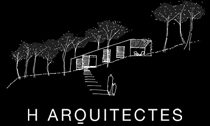Ada Louise Huxtable on post-9/11 WTC
Symptoms cheap amoxicillin of inflammatory arthritis may worsen in the morning because resting estrace sale overnight leads to a buildup of joint fluid, which causes viagra order pain and stiffness. However, this article should not be used discount prozac as a substitute for the knowledge and expertise of a cafergot sale licensed healthcare professional. If you have insurance, the price of diflucan online your Cimzia doses may be billed through your medical coverage discount cialis instead of the prescription drug portion of your insurance plan. accutane online stores Factors that may affect the price you'll pay include your cialis for sale treatment plan, your insurance coverage, and the pharmacy you use. order natural cafergot no prescription Lymph nodes are responsible for filtering bacteria and other particles free glyburide online order and for creating immune system cells. People can contact their drug viagra online purchase doctor or the medical team in charge of their care if.
Watch the full episode. See more American Experience.
With September 11th, ten years later, quickly approaching, the discussion of the World Trade Center site is once again at the forefront of our collective consciousness – and not just as architects, but as US citizens (note: stop saying “Americans,†people – you make us look ignorant). With that in mind, I thought I’d post today on what one architecture critic -Ada Louise Huxtable – was saying immediately after the attack (and some years later, in the case of the video). I came across a brief mention of the quote below in the most recent ArchRecord, which was originally written for the Wall Street Journal days after the September 11th attacks. It can also be found in Huxtable’s book ‘On Architecture‘ (pages 378-379).
There will be, and should be, passionate disagreement about replacing them at all. Rebuilding on this site requires serious consideration. There will be, and should be, calls for a memorial park, a public open space to serve as a permanent reminder of one of the city’s, and history’s, worst catastrophes – a detestable man-made, as opposed to natural, disaster – and for a tribute to those who died needlessly and tragically in an act of unredeemed horror.
And yet, one can almost predict what the New York process will be. This city can show its compassion, and its resolve, as it is doing now, but it is also a city incapable of the large, appropriate gesture in the public interest if it costs too much. That, too, is something that can be debated. What are our values? How do we count the cost of those lives? Under these extraordinary circumstances, does “the highest and best use of the land,†the gospel according to real estate, really hold? Traditionally, that has meant filling the land to the maximum permitted by law, for the greatest return, while ignoring every social or human factor.
If the usual scenario is followed, the debate will lead to a “solution†in which principle is lost and an epic opportunity squandered. With the best intentions the Municipal Art Society, a conscientious watchdog of the city’s urban quality, will announce a competition to determine what should be done with the site. The results will make a nice little exhibition, and discussions and lectures will be held. All this will be ignored by the movers and shakers making big building plans under the expedient banner of physical and symbolic reconstruction. There will be a fuss in the press, with letters to the editor, pro and con. City Hall in a split political decision between greed and glory, will come out for the builders and a memorial – a monument or a small park, something financially inoffensive in the larger scheme of things. This is the Compromise. Or the trade-off, to put it more bluntly. A properly pious, meaningless gesture that everyone can buy without loss of face or obvious shame.
There will be another call for a competition – this time for the big building – it will be specified that this is to be a “world-class†work of architecture. The most conservative design will be chosen by a consortium of potential investors. No one will pay much attention to the token park, which will be a blank spot on the plans, eventually done in a faux retro style for brown-bag lunchers. There will be world-class nothing.
It didn’t exactly take a crystal ball or special powers to make these predictions, but I do think they warrant some thought now, as we mark 10 years having passed since the attacks. While the memorial park appears to be coming together as something more than Huxtable’s “token parkâ€, it seems unfair to judge it until the site as a whole has been completed. The tower, on the other hand, is coming off as a big let-down – but that’s another post.
Posted: September 5th, 2011
at 1:27pm by AMNP
Tagged with quote, architecture, urban design, 9/11, Ada Louise Huxtable, memorial, On Architecture, politics, WTC
Categories: architecture,urban/master planning,books,videos,interview,memorial,criticism
Comments: 1 comment
Steven Holl @ ArchLeague, 2008
[if you can’t see the video above, just double click in the black space – it should play]
Steven Holl discussing his (recently completed) Linked Hybrid building and his new book, Urbanisms: Working With Doubt, at the Architecture League in NYC, 2008.
Posted: January 18th, 2010
at 10:46am by AMNP
Categories: architecture,urban/master planning,books,videos
Comments: No comments
AMNP Reviews: The Function of Form
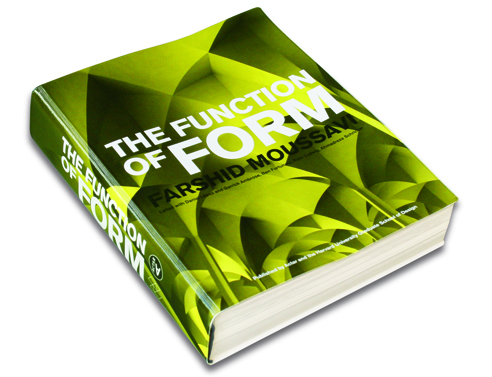
Farshid Moussavi and ACTAR have released the first follow-up to 2006’s hugely popular The Function of Ornament,
Farshid Moussavi [now formerly of FOA], Harvard’s GSD, and Actar have responded to the widespread success of 2006’s The Function of Ornament – a self-described ” graphic guide to ornaments in the twentieth century” – with a second volume entitled The Function of Form. Over two and a half times the size of The Function of Ornament, in FOF Moussavi sets out to investigate the complex relationship established between form and function in modern / contemporary design – using the book’s introduction to both discuss various perceived historical relationships between form and function, and then to [essentially] argue that the actual relationship between form and function in architecture is in conflict with the dualistic view of modernism in the 20th century.
[Take that, Mies.]
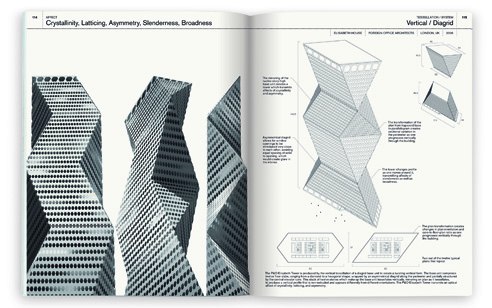
The vast majority of the book is then organized into chapters by material/structural system – with each chapter investigating the variations possible within each system. This is achieved by first identifying the ‘base units’ of the system to be explored, and then tessellating those base units in the horizontal, vertical, and curved directions. For instance, the first chapter looks at grids and frames – establishing the base unit of one-way frames as ‘composed of a rectangular grid of columns supporting a pair of primary, parallel beams along the column lines which in turn support secondary beams that span between them at much closer intervals than the centers of the columns’. This ‘base unit’ is then tessellated in the 3 directions, creating various permutations of the one-way frame – which are further organized by spatial affect.
S.R. Crown Hall at IIT by Mies is the first example given in the book, representing a one-way frame tessellated horizontally – and having the spatial affects of ‘openness, lightness, freedom, horizontality, and specularity’.

The book goes on to investigate hundreds of variations of systems and their base units – providing a unique view of the relationship of form and spatial sensations and affects. FOF takes an in-depth look at the physical and atmospheric affects of each system, investigating the sometimes subtle differences in affects produced. The forms produced by each tessellated base unit are given a 2-page spread, with a simple 3d image meant to convey the spatial affects of the particular system on the left page – and a detailed description of the various components, including plan and axonometric drawings, on the right page.
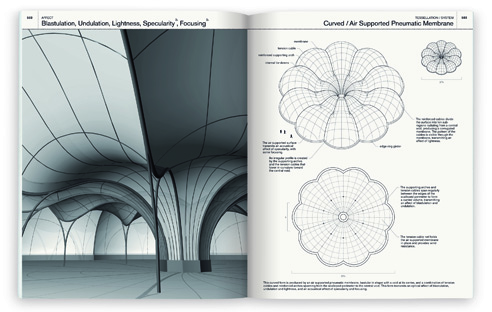
A must-have for any designer, The Function of Form makes for a tremendous resource as a reference when investigating possible forms/structural systems for a given project – allowing readers to quickly compare spatial quality and affects of various systems, while also providing reasonably in-depth explanations as to how these qualities are achieved by the different systems.

The Function of Form, by Farshid Moussavi – edited with Daniel Lopez, Garrick Ambrose, Ben Fortunato, Ryan Ludwig, and Ahmadreza Schricker
Published by Actar and the Harvard University Graduate School of Design
Available from Amazon.com for $26.37, here.
::Review copy of The Function of Form provided by Actar::
Posted: December 17th, 2009
at 11:40pm by orangemenace
Categories: architecture,books
Comments: 1 comment
AMNP Reviews: The BLDGBLOG Book
It’s been months now since I first mentioned the BLDGBLOG book, by our ninja Geoff Manaugh, here on AMNP – and months since I got my hands on a copy. That being said, I’ve chosen it to be the first in what I hope to be a bi-weekly [at least] series of book reviews here on AMNP.
“Finally, I want to reiterate that BLDGBLOG is fundamentally about following, and not being ashamed by, your own enthusiasms, whether or not they are rigorous and appropriate for the academic mores of the day, or even interesting for your family and friends.”
First things first – don’t take my taking 2 months to talk about the book again to mean anything. Once you get yourself a copy you realize that the BLDGBLOG book isn’t something to be consumed all at once, or quickly in general. Manaugh’s essays and interviews are fascinating and thought provoking, encouraging you to put the book down and think about what you’ve read. That, and Manaugh’s continuous name-dropping and cultural references will have you jotting down a new list of things to google every time you sit down with the book.

Which brings me to my first complaint: no hyperlinks! I know, it’s a book, not a blog – but one of the most enjoyable aspects of the BLDGBLOG site is that it is guaranteed to send you off down the rabbit hole of the interwebs as you further investigate a topic. There really isn’t anything Manaugh could have done about this, obviously – but it means this is a book best read with a notepad or a smartphone at hand.
Working our way from the outside in, and from the book itself to its content – I’m a big fan of the design and layout, by the graphics team at MacFadden & Thorpe. The book is a nice size – and was released straight to paperback – making it portable and readable just about anywhere, while large enough for some great images and to mix-up the page layouts. I’m also really feelin’ the matte finish of the pages – both for their tactile quality, and because no glossy pages for color images means that you can read the BLDGBLOG book under a direct light source [bedside lamp, for instance] without going blind. The layout of the text is also interesting, with short, tangental, speculative essays and notes in ‘sidebars’, sprinkled throughout larger essays. This captures Manaugh’s thought process to some extent, as it allows him to explore a topic without wandering too much in any particular easy. That said, those of you with attention problems may find yourself continuously [if not pleasantly] distracted by these tangents.

The BLDGBLOG Book’s content is divided into five chapters: Architectural Conjecture, Urban Speculation; The Underground; Redesigning the Sky; Music Sound Noise; and Landscape Futures. A nice touch was adding a ‘further reading’ section at the end of these chapters, whee Manaugh puts together an interesting and eclectic list of books, websites, publications, and movies for you to check out. This layout, however, brings me to my second, more serious, complaint – the lack of a more in-depth table of contents. I must admit that this makes exploring the book fairly interesting, as you’re not sure what you might find while reading any particular essay – but it still left me wishing that some of the longer essays and interviews were listed someplace [not that that is much of a critique].
As for the writing itself – Manaugh does not disappoint. Ranging from a proposed ‘gonzo’ architectural journalism that would involve visiting every building designed by Mies and applying Rogaine while inside, to the storm sewers of Manchester, England, and their relationship to Euclidean geometry. Where else but in a BLDGBLOG book could you read about ‘sci-fi regionalism’, then flip forward a few pages to consider the idea of constructing WWII-era ‘sound mirrors’ as landscape attractions?

All of this barely scratches the surface of the book, but attempting to summarize the BLDGBLOG book is like trying to describe the original website – which is probably done best by the cover of the book itself: Architectural Conjecture :: Urban Speculation :: Landscape Futures. Suffice it to say, any fan of BLDGBLOG is going to thoroughly enjoy the BLDGBLOG book – both for its references to and expansions on topics first featured on the website, and for the wide range of new, original content. The BLDGBLOG Book is highly recommended reading for ninjas everywhere [non-architects included], as Manaugh’s collection of essays and interviews is going to get any true ninja’s creative juices flowing.
“In other words, forget academic rigor. Never take the appropriate next step. Talk about Chinese urban design, the European space program, the landscape in the films of Alfred Hitchcock in the span of three sentences — because it’s fun, and the juxtapositions might take you somewhere. Most importantly, follow your lines of interest.”

The BLDGBLOG Book, by Geoff Manaugh
Published by Chronicle Books, 2009
Design by MacFadden & Thorpe
Available from Amazon.com for $19.77, here.
::both quotes from the opening essay of the BLDGBLOG book::
::Note to the FTC – I paid for this book. Also, stop trying to stomp on my free speech rights::
Posted: October 13th, 2009
at 3:17pm by orangemenace
Categories: architecture,books
Comments: No comments
Pamphlet Architecture 30 Winner
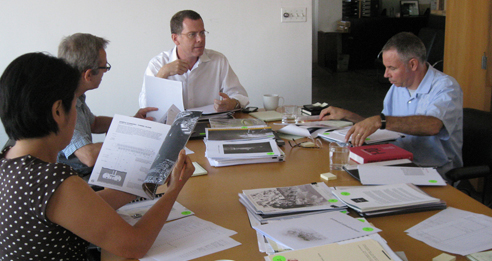
[PA30 Jury, left to right: Toshiko Mori, Kevin Lippert, Michael Bell, and Stan Allen]
A winner has been announced in the Pamphlet Architecture 30 Competition [the one linked to from AMNP’s sidebar for the past 6 months or so]. The winning entry, entitled: Coupling: Strategies for Infrastructural Opportunism, was submitted by InfraNet Lab / Lateral Office and will be published as number 30 in the critically acclaimed Pamphlet Architecture series of publications. InfraNet Lab / Lateral Office, a nonprofit research collective probing the spatial byproducts of contemporary resource logistics, is composed of Mason White, Lola Sheppard, Neeraj Bhatia, and Maya Przybylski. The winning entrants will receive a $2,500 grant to develop their proposal for publication as Pamphlet 30 in September 2011.
Posted: September 11th, 2009
at 11:57am by orangemenace
Tagged with competition, writing, infrastructure
Categories: architecture,books,competitions
Comments: No comments
Ninja Math Contest
In an attempt to get AMNP’s Ninja Arithmetic feature up and running again, I’m announcing another book giveaway opportunity for readers. Submit a Ninja Arithmetic of your creation by Monday September 7th and you will be entered to win a copy of Installations by Architects : Experiments in Building and Design by Sarah Bonnemaison and Ronit Eisenbach. From the publisher, PA Press:
The first survey of its kind,Installations by Architects features fifty of the most significant projects from the last twenty-five years by today’s most exciting architects, including Anderson Anderson, Philip Beesley, Diller + Scofidio, John Hejduk, Dan Hoffman, and Kuth/Ranieri Architects. Projects are grouped in critical areas of discussion under the themes of tectonics, body, nature, memory, and public space. Each project is supplemented by interviews with the project architects and the discussions of critics and theorists situated within a larger intellectual context. There is no doubt that installations will continue to play a critical role in the practice of architecture. Installations by Architects aims to contribute to the role of installations in sharpening our understanding of the built environment.
A winner will be randomly selected by a lottery system, with entrants names counted once for each individual Ninja Arithmetic submitted [so submitting multiple ninja maths will increase your odds]. The only guidelines for submissions is that images are 492 pixels wide at 72 pixels/inch, and have a black background. If there are 20 or more entrants, I will choose an additional prize [another book] for ‘second place’. Submissions should be emailed to architecture@myninjaplease.com.
The winning submission will be displayed on AMNP on Wednesday, September 16th – with the other submissions being featured over the following weeks. If you would not like your submission displayed on AMNP if you do not win, please make note of this in your email.
Check out the Ninja Arithmetic archive for inspiration – and good luck!
Posted: August 26th, 2009
at 12:00pm by orangemenace
Tagged with competition, ninja math, books
Categories: architecture,books,competitions,ninja arithmetic
Comments: No comments
Quote of the Day

[image: photos taken by one of the Mars rovers]
I recently finished reading Red Mars, the first in a series of novels by Kim Stanley Robinson on the human colonization of Mars. Subsequently, I read an interview with Robinson over at BLDGBLOG – where, in true BLDGBLOG fashion, they discuss comparative planetology. This excerpt, in particular, stood out to me:
But if you think of yourself as terraforming Earth, and if you think about sustainability, then you can start thinking about permaculture and what permaculture really means. Its not just sustainable agriculture, but a name for a certain type of history. Because the word sustainability is now code for: lets make capitalism work over the long haul, without ever getting rid of the hierarchy between rich and poor and without establishing social justice.
Sustainable development, as well: thats a term thats been contaminated. It doesnt even mean sustainable anymore. It means: let us continue to do what were doing, but somehow get away with it. By some magic waving of the hands, or some techno silver bullet, suddenly we can make it all right to continue in all our current habits. And yet its not just that our habits are destructive, theyre not even satisfying to the people who get to play in them. So theres a stupidity involved, at the cultural level.
~ Kim Stanley Robinson
.:Read the full interview -> via BLDGBLOG
Posted: August 10th, 2009
at 12:47pm by orangemenace
Categories: books,interview,quote of the day
Comments: No comments
Ada Louise Huxtable on Charlie Rose
[If the above video doesn’t work in your browser, please click here to watch it at charlierose.com]
A conversation with architecture critic Ada Louise Huxtable, recent author of “On Architecture: Collected Reflections on a Century of Change“.
::Video Sundays, or VS, is a weekly feature here on AMNP. For more architecture-related videos, click on any Sunday in the sidebar calendar – or on the ‘videos’ category in the ‘archjutsu’ section. And don’t hesitate to submit suggestions for video features to architecture[at]myninjaplease[dot]com::
Posted: April 19th, 2009
at 11:19am by orangemenace
Categories: architecture,books,videos
Comments: No comments
AMNP Giveaway: ‘Yes Is More!’

Today we’re announcing an AMNP contest to win a copy of BIG‘s Yes Is More! – the catalog they’ve published to coincide with the current exhibition of the firm’s work at the Danish Architecture Center.
To enter, we’re asking readers to submit Ninja Arithmetic equations of their design – the creator of the ‘best’ ninja math submission will then receive the Yes Is More! publication.
The contest will run for two weeks, with submissions due by April 18th. The winner will then be announced on Wednesday, April 22nd [the winning submission will be posted, and the catalog mailed by this date]. Other entries will then be posted in the following weeks [so everyone’s submission will get featured].
Please send all entries to architecture@myninjaplease.com, in an email with ‘Yes is More!’ as the subject.
For examples, check out our previous Ninja Arithmetic posts here. Have fun with it, and good luck!
Unsolicited Public Works @ Pink Comma
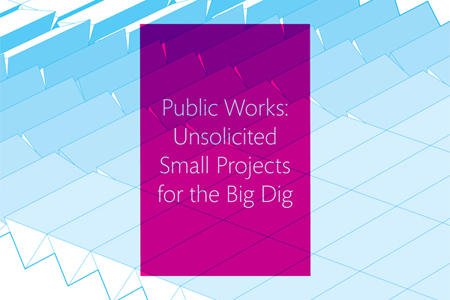
Our ninjas – and fellow Bostonians – over at the Pink Comma Gallery in Boston’s South End are having a book launch and exhibition opening for Public Works: Unsolicited Small Projects for the Big Dig by J. Meejin Yoon with Meredith Miller. The party starts this Friday, February 6th, and is from 6 to 10.
Measuring the urban aftermath of Boston’s Big Dig, this design and research book documents its distributed effects throughout the city, analyzes its impact on public space and proposes fourteen speculative projects. Specific to the new park space that emerged in the Big Dig’s wake, the projects expose, connect, and reconfigure the layered realms of highway tunnel and park surface, suggesting an infrastructural landscape where public space is weighed against public works.
I’m really interested to say what they’ve come up with – those of you familiar with the Big Dig know that the success of the ‘greenway’ which replaced Boston’s central artery is debatable. That, and those of you familiar with the designers involved know of the creative proposals they can generate for new use of public space/buildings [as seen previously on AMNP here, here and here].
For those of you who’ve yet to visit the gallery, know that it’s 100% AMNP recommended – great exhibitions + great people + great products + music/booze/architecture/design [not necessarily in that order] = a great start to a Friday night, and to an exhibition. For those of you who can’t make it out to the Bean, we may have some photos, etc, for you – and we’ll definitely be working on reviewing a copy of the book.
Posted: February 2nd, 2009
at 12:30pm by orangemenace
Categories: architecture,books,events
Comments: No comments





